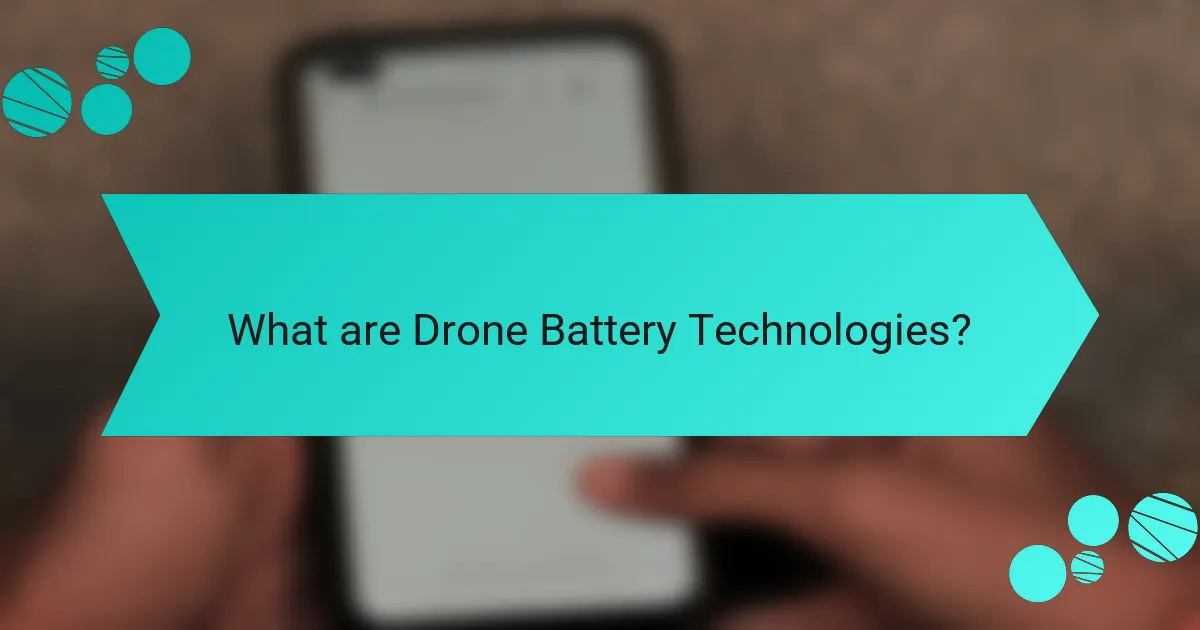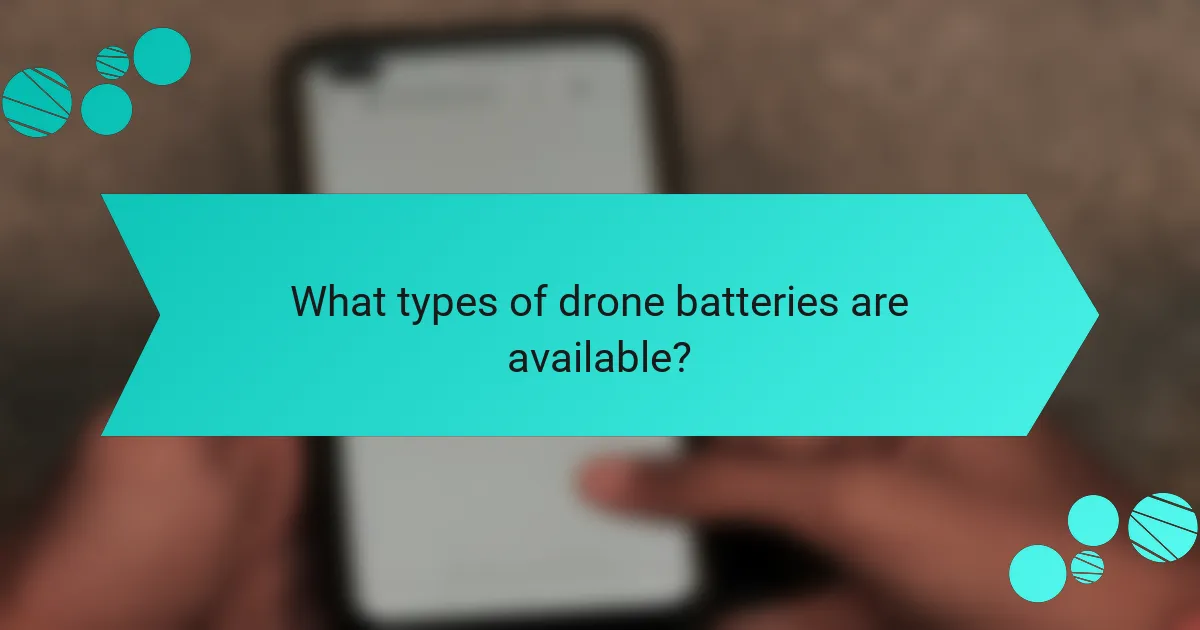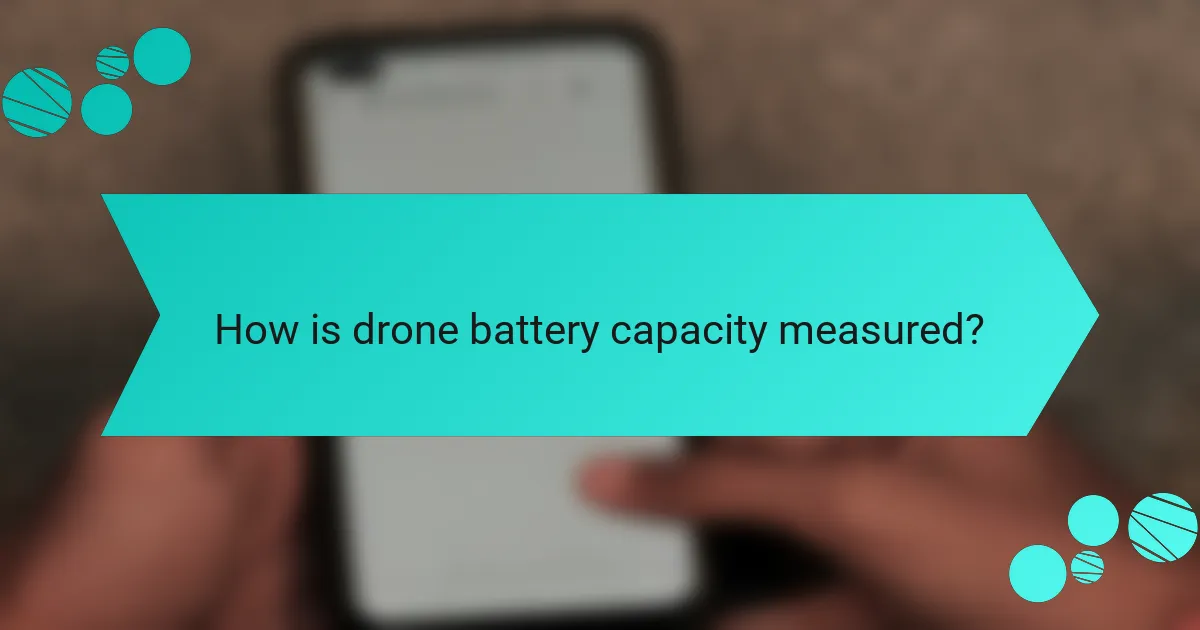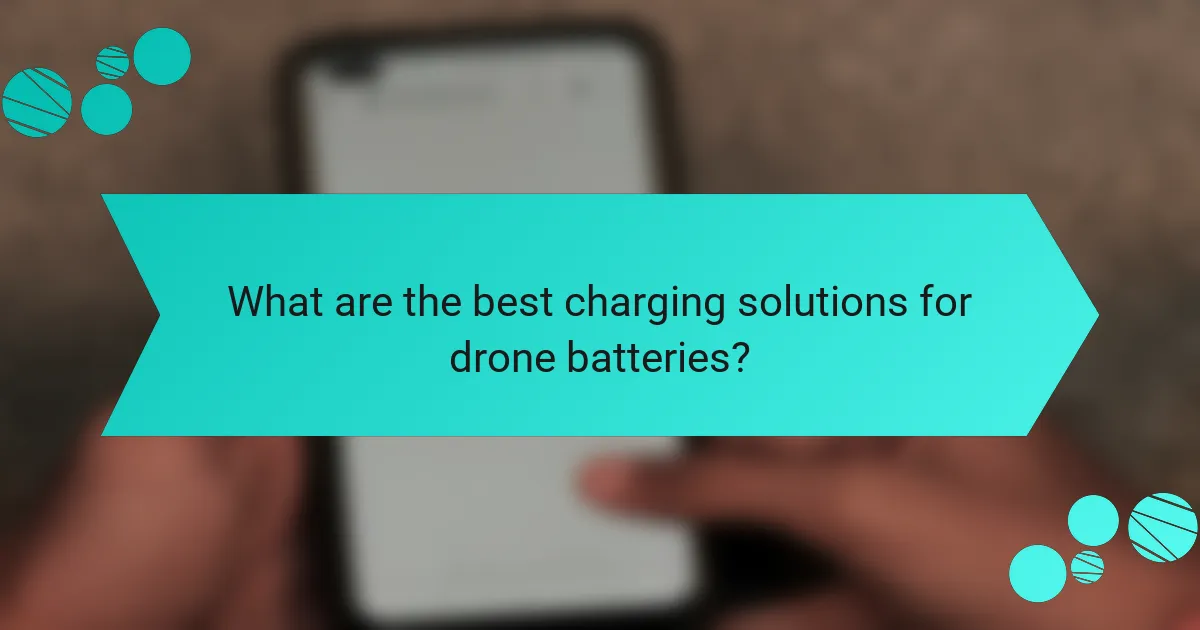
What are Drone Battery Technologies?
Drone battery technologies refer to the various types of batteries used to power drones. These technologies include lithium-ion, lithium-polymer, and nickel-metal hydride batteries. Lithium-ion batteries are the most common due to their high energy density and lightweight properties. They typically offer a capacity range from 1000 mAh to over 5000 mAh, depending on the drone model. Lithium-polymer batteries provide flexibility in shape and size, making them suitable for various drone designs. Nickel-metal hydride batteries are less common but can be used in specific applications. The choice of battery technology impacts flight time, weight, and overall drone performance.
How do drone batteries differ from traditional batteries?
Drone batteries typically use lithium polymer (LiPo) technology, while traditional batteries often utilize lead-acid or nickel-cadmium types. LiPo batteries are lighter and can provide higher energy density. This allows drones to achieve longer flight times and enhanced performance. Traditional batteries, on the other hand, are generally heavier and bulkier. They also have slower discharge rates compared to LiPo batteries. Furthermore, drone batteries are designed for rapid charging and discharging cycles. In contrast, traditional batteries may require longer charging times and have shorter lifespans under similar conditions. These differences make drone batteries more suitable for the demands of aerial applications.
What specific attributes define drone batteries?
Drone batteries are defined by several specific attributes. Key attributes include capacity, voltage, discharge rate, and chemistry type. Capacity is measured in milliampere-hours (mAh) and determines the energy storage. Voltage indicates the electrical potential and affects performance. Discharge rate, expressed as C-rating, shows how quickly a battery can release energy. Chemistry type refers to the materials used, such as lithium-polymer (LiPo) or lithium-ion (Li-ion). These attributes influence flight time, weight, and overall efficiency. For instance, higher capacity leads to longer flight durations. Understanding these attributes is essential for selecting the right battery for specific drone applications.
How do these attributes impact drone performance?
Attributes such as battery type, capacity, and charging solutions significantly impact drone performance. Battery type influences weight, energy density, and discharge rates. For instance, lithium polymer batteries offer high energy density, enabling longer flight times. Capacity, measured in milliampere-hours (mAh), determines how long a drone can operate before needing a recharge. A higher capacity allows for extended flight durations, which is crucial for tasks like aerial photography or surveying.
Charging solutions affect downtime and convenience. Fast-charging technologies can reduce the time a drone spends on the ground, allowing for quicker turnaround between flights. Additionally, the choice of charging infrastructure can influence operational efficiency, especially in commercial applications. For example, drones used in delivery services benefit from rapid charging capabilities to maximize delivery frequency.
Overall, these attributes directly correlate with a drone’s operational capabilities, efficiency, and suitability for specific tasks.
Why is battery technology crucial for drone operations?
Battery technology is crucial for drone operations because it directly impacts flight time, efficiency, and performance. Drones rely on batteries to provide the necessary power for propulsion and onboard systems. The capacity of a battery determines how long a drone can stay airborne. High-capacity batteries enable longer missions, which is essential for applications like aerial photography and surveying. Additionally, advancements in battery technology improve energy density, allowing drones to carry more payload without increasing weight. Efficient charging solutions are also vital for minimizing downtime between flights. Overall, the effectiveness of drone operations heavily depends on the quality and innovation of battery technology.
What role does battery life play in drone functionality?
Battery life is crucial for drone functionality as it directly impacts flight time and operational range. A longer battery life allows drones to stay airborne for extended periods. This is essential for tasks like aerial photography, surveying, and search and rescue missions. Insufficient battery life can lead to premature landings, limiting the drone’s effectiveness. For example, consumer drones typically have flight times ranging from 20 to 30 minutes. In contrast, professional drones may achieve up to 60 minutes of flight time with advanced battery technologies. Thus, battery life influences mission planning and overall performance in various applications.
How does battery technology affect flight time and range?
Battery technology directly influences flight time and range in drones. Higher energy density batteries allow for longer flight times. For instance, lithium-polymer batteries typically provide more energy than older nickel-cadmium types. This translates to extended operational range and duration.
Additionally, advancements in battery management systems optimize energy usage. Efficient power distribution and monitoring enhance overall performance. Research indicates that drones equipped with high-capacity batteries can achieve flight times exceeding 30 minutes, compared to 15 minutes for lower-capacity alternatives.
In summary, improved battery technology enhances both flight time and range significantly.

What types of drone batteries are available?
Lithium Polymer (LiPo), Lithium-ion (Li-ion), and Nickel-Metal Hydride (NiMH) are the main types of drone batteries available. LiPo batteries are popular for their high energy density and lightweight design. They provide high discharge rates, making them suitable for racing and aerial photography drones. Li-ion batteries offer longer life cycles and higher capacity compared to LiPo. They are often used in larger drones requiring extended flight times. NiMH batteries are less common but provide a safer alternative with better thermal stability. They are typically used in beginner drones or models where weight is not a critical factor. Each battery type has unique attributes that cater to different drone applications and user needs.
What are the most common types of drone batteries?
The most common types of drone batteries are Lithium Polymer (LiPo), Lithium-Ion (Li-Ion), and Nickel-Metal Hydride (NiMH) batteries. LiPo batteries are widely used due to their high energy density and lightweight properties. They typically provide high discharge rates, making them suitable for high-performance drones. Li-Ion batteries are known for their longevity and stable performance. They have a higher energy capacity compared to LiPo batteries. NiMH batteries are less common but are valued for their safety and durability. They are often used in lower-end drones and toy models. Each battery type has unique characteristics that make it suitable for different drone applications.
How do LiPo batteries compare to Li-ion batteries?
LiPo batteries and Li-ion batteries differ primarily in their chemical composition and performance characteristics. LiPo batteries, or lithium polymer batteries, use a polymer electrolyte which allows for flexible shapes and lightweight designs. This makes them ideal for applications like drones where weight is critical.
In contrast, Li-ion batteries, or lithium-ion batteries, utilize a liquid electrolyte. This generally results in higher energy density compared to LiPo batteries, allowing them to store more energy in a similar volume.
LiPo batteries typically have a lower energy density than Li-ion batteries. For example, LiPo batteries can have an energy density around 150 Wh/kg, while Li-ion batteries can exceed 250 Wh/kg.
Additionally, LiPo batteries often have a higher discharge rate, making them suitable for high-performance applications. However, they can be more sensitive to overcharging and require more careful handling.
Li-ion batteries tend to have a longer lifespan and better cycle stability, lasting more charge cycles before capacity diminishes.
Overall, the choice between LiPo and Li-ion batteries depends on the specific requirements of the application, such as weight, energy density, and discharge rates.
What are the advantages and disadvantages of NiMH batteries?
NiMH batteries have several advantages and disadvantages. Advantages include higher energy density compared to NiCd batteries. They are less toxic and environmentally friendly. NiMH batteries also have a lower self-discharge rate. This allows for longer shelf life when not in use. Disadvantages include a lower voltage per cell compared to lithium-ion batteries. They can suffer from memory effect if not fully discharged. NiMH batteries also have a shorter lifespan than lithium-ion batteries. Their performance can degrade at high temperatures.
What factors should be considered when choosing a drone battery type?
When choosing a drone battery type, consider capacity, weight, discharge rate, and charging time. Capacity, measured in milliamp hours (mAh), determines flight duration. A higher capacity allows for longer flights but increases weight. Weight affects the drone’s performance and flight efficiency. Discharge rate, expressed as C-rating, indicates how quickly a battery can deliver power. A higher discharge rate supports more demanding applications, like racing or heavy lifting. Charging time varies by battery type; faster charging is beneficial for frequent use. Finally, battery chemistry, such as LiPo or Li-ion, influences performance and safety. Each factor plays a crucial role in optimizing drone operation and user experience.
How does weight affect battery selection for drones?
Weight significantly affects battery selection for drones. Heavier drones require batteries with higher capacity to maintain flight time and performance. The battery’s weight must be balanced against the drone’s overall weight for optimal efficiency. A heavier battery can reduce payload capacity and maneuverability. Conversely, lightweight batteries may not provide sufficient power for larger drones. Selecting the right battery involves considering both weight and energy density. For example, lithium-polymer batteries offer high energy density relative to their weight. This balance is crucial for maximizing flight duration and operational efficiency.
What is the impact of environmental conditions on battery choice?
Environmental conditions significantly impact battery choice for drones. Temperature extremes can affect battery performance and lifespan. For instance, lithium polymer batteries may lose capacity in cold conditions. High temperatures can lead to overheating and potential failure. Humidity affects battery corrosion and can reduce efficiency. Therefore, selecting batteries suited for specific environmental conditions is crucial. Research indicates that batteries designed for harsh environments often feature enhanced materials and cooling systems. This ensures reliable operation in varying climates.

How is drone battery capacity measured?
Drone battery capacity is measured in milliampere-hours (mAh) or watt-hours (Wh). The mAh rating indicates the total charge a battery can hold. Higher mAh values generally mean longer flight times. Watt-hours provide a measure of energy capacity, factoring in voltage. To calculate watt-hours, multiply the voltage by the amp-hour rating. For example, a 3S 2200mAh battery at 11.1V has a capacity of 24.42Wh. This measurement is crucial for assessing drone performance and endurance.
What units are used to measure battery capacity?
Battery capacity is primarily measured in ampere-hours (Ah) or milliampere-hours (mAh). These units quantify the total charge a battery can deliver over a specific period. For instance, a battery rated at 2000 mAh can supply 2000 milliamperes for one hour. This measurement is crucial for understanding how long a battery can power a device before needing a recharge. Commonly, larger batteries used in drones may be rated in Ah, while smaller batteries often use mAh for precision.
How do mAh ratings influence drone performance?
mAh ratings directly influence drone performance by determining battery capacity. Higher mAh ratings indicate a greater energy storage capacity. This allows drones to fly longer before needing a recharge. For example, a drone with a 3000 mAh battery can typically fly for 20-30 minutes, depending on its power consumption. In contrast, a 1500 mAh battery may only support 10-15 minutes of flight time. Additionally, mAh ratings affect payload capacity and flight stability. Higher capacity batteries can support heavier payloads without compromising flight duration. Therefore, selecting the right mAh rating is crucial for achieving optimal drone performance.
What is the significance of voltage in battery capacity?
Voltage is significant in battery capacity because it determines the amount of energy a battery can deliver. A higher voltage typically means more energy available for use. For instance, a 12V battery can provide more power than a 6V battery of the same capacity. The energy stored in a battery is calculated using the formula: Energy (Wh) = Voltage (V) x Capacity (Ah). This shows how voltage directly influences the total energy output. Therefore, understanding voltage is crucial for optimizing battery performance in applications like drones.
Why is understanding battery capacity important for drone users?
Understanding battery capacity is crucial for drone users because it directly affects flight time and performance. Battery capacity determines how long a drone can operate before needing a recharge. For instance, a drone with a 5000 mAh battery can typically fly longer than one with a 3000 mAh battery. Knowing the capacity helps users plan flights effectively. It allows them to estimate how far they can travel and how much payload they can carry. Additionally, understanding capacity aids in selecting the right battery for specific drone models. This knowledge can prevent mid-flight failures due to insufficient power. Overall, battery capacity is a key factor in optimizing drone usage and ensuring safety during operations.
How does capacity relate to flight time and payload?
Capacity directly influences flight time and payload in drones. Higher battery capacity allows for longer flight durations. This is because more energy storage translates to extended operational time. Conversely, increased payload can reduce flight time. Heavier loads require more energy to maintain flight, thus shortening battery life. For example, a drone with a 5000 mAh battery can fly longer than one with a 3000 mAh battery under similar conditions. Additionally, carrying a heavier payload may reduce the total flight time by up to 30%. Therefore, capacity is a critical factor in balancing flight time and payload capabilities.
What are common misconceptions about battery capacity?
Common misconceptions about battery capacity include the belief that a higher capacity always means longer usage time. Battery capacity is measured in milliampere-hours (mAh), which indicates the total energy a battery can store. However, actual usage time depends on the device’s power consumption. Another misconception is that all batteries with the same capacity perform identically. Different battery chemistries can lead to variations in efficiency and discharge rates. It’s also commonly thought that battery capacity remains constant over time. In reality, battery capacity degrades with cycles of charging and discharging. Lastly, many believe that charging a battery to 100% is always best for longevity. Frequently charging to full capacity can actually reduce a battery’s lifespan.

What are the best charging solutions for drone batteries?
The best charging solutions for drone batteries include smart chargers, rapid chargers, and solar-powered chargers. Smart chargers optimize charging cycles based on battery type and condition. They prevent overcharging and extend battery lifespan. Rapid chargers significantly reduce charging time, allowing for quick turnaround between flights. Solar-powered chargers provide an eco-friendly option, utilizing renewable energy for charging. Each solution caters to different operational needs and battery types, enhancing efficiency and convenience. For instance, smart chargers can improve battery health by managing charge rates effectively.
What types of chargers are available for drone batteries?
There are several types of chargers available for drone batteries. The most common types include standard chargers, smart chargers, and rapid chargers. Standard chargers are basic devices that typically take longer to charge batteries. Smart chargers have advanced features, allowing for monitoring and optimizing the charging process. Rapid chargers can significantly reduce charging time, often using higher power outputs. Additionally, some drones utilize USB chargers for convenience. Each charger type serves specific battery chemistry and capacity requirements, ensuring compatibility and efficiency.
How do smart chargers enhance battery life and performance?
Smart chargers enhance battery life and performance by optimizing the charging process. They utilize advanced algorithms to monitor battery conditions. This includes voltage, temperature, and charge cycles. By adjusting the current and voltage, smart chargers prevent overcharging and overheating. This leads to reduced wear on battery cells. Studies show that proper charging can extend battery lifespan by up to 50%. Additionally, smart chargers can provide maintenance charging. This keeps batteries at optimal levels without overcharging. Overall, smart chargers improve efficiency and longevity of batteries in drones.
What safety features should be considered in charging solutions?
Safety features that should be considered in charging solutions include overcurrent protection, overvoltage protection, and thermal management. Overcurrent protection prevents excessive current flow, which can lead to overheating and battery damage. Overvoltage protection safeguards against voltage spikes that could compromise battery integrity. Thermal management systems monitor and regulate temperature during charging to prevent overheating. Additionally, short-circuit protection is crucial to prevent damage from unintended electrical connections. Finally, implementing smart charging technology enhances safety by adjusting charge rates based on battery condition. These features collectively ensure safer charging practices and prolong battery lifespan.
How can users optimize charging practices for drone batteries?
Users can optimize charging practices for drone batteries by following specific guidelines. First, charge batteries at room temperature to prevent overheating. Overheating can lead to battery damage and reduced lifespan. Second, avoid fully discharging batteries before recharging. Lithium-based batteries perform best when kept between 20% and 80% charge. Third, use a charger specifically designed for the battery type. Using the correct charger ensures proper voltage and current levels. Fourth, regularly check battery health and replace old batteries. Aging batteries may not hold charge effectively. Lastly, avoid leaving batteries plugged in after reaching full charge. This practice can prevent overcharging, which can degrade battery performance over time. Following these practices can significantly enhance the lifespan and efficiency of drone batteries.
What are best practices for charging LiPo batteries?
Charge LiPo batteries using a dedicated LiPo charger. This ensures safe and efficient charging. Set the charger to the correct cell count and voltage. Most LiPo batteries are 3.7V per cell. Always monitor the charging process. Do not leave batteries unattended while charging. Charge at a safe rate, typically 1C or less. Store batteries at a voltage of 3.8V per cell for optimal longevity. Follow these practices to minimize risks of fire or damage.
How can users troubleshoot common charging issues?
Users can troubleshoot common charging issues by following a series of steps. First, check if the charger is properly connected to both the outlet and the drone. A loose connection can prevent charging. Next, inspect the charging cable for any visible damage. Frayed or broken cables can disrupt the charging process.
Additionally, ensure that the power outlet is functional by testing it with another device. If the outlet works, examine the drone’s battery for any signs of wear or swelling. A damaged battery may not charge properly.
Users should also verify that the charger is compatible with the drone model. Using an incorrect charger can lead to charging failures. Finally, if issues persist, reset the drone’s battery management system according to the manufacturer’s instructions. This can often resolve software-related charging problems.
What tips can enhance the longevity of drone batteries?
To enhance the longevity of drone batteries, follow these tips. Always store batteries at a moderate temperature, ideally between 20°C and 25°C. Avoid exposing batteries to extreme heat or cold, as this can damage their cells. Regularly check battery voltage and charge levels. Keeping batteries between 20% and 80% charged can prevent stress on the cells. Use the manufacturer’s recommended charger to ensure optimal charging conditions. Avoid over-discharge, as it can lead to irreversible capacity loss. Perform periodic maintenance by cycling the battery every few months. This practice helps to balance the cells and maintain performance. Following these guidelines can significantly extend the lifespan of drone batteries.
Drone battery technologies encompass various types of batteries, including lithium-ion, lithium-polymer, and nickel-metal hydride, each with distinct attributes affecting flight time, weight, and performance. Key factors such as capacity, voltage, discharge rate, and battery chemistry play crucial roles in determining a drone’s operational capabilities. The article explores how these attributes influence drone functionality, the differences between drone and traditional batteries, and the importance of battery technology in enhancing flight efficiency. Additionally, it examines optimal charging solutions and best practices for maintaining battery longevity, providing essential insights for users seeking to maximize drone performance.



